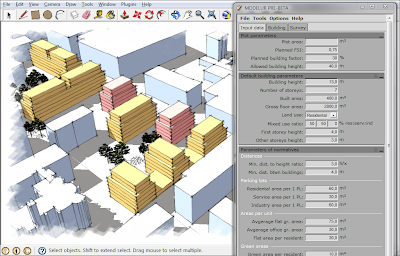Hi Chris,
thanks for sharing your observations!
@unknownuser said:
I very much like the idea of Modelur as a plugin to Sketchup principally because I believe that human activity just has to become object oriented. Sketchup or something similar might be a word processor offering 3D models instead of paragraphs to house and communicate information. Accessing and retrieving the information has to be web based; Modelur's use of a web dialog is a major step in that direction; Modelur's idea of reporting to a spreadsheet with comma separated values is decidedly not.
I agree on that, I believe that web based, multi user environments are next step of computer applications development, which offers huge potentials. However, as long as we stick to SketchUp, we are limited to its API and the features SU offers. Of course we would love to see SU become web based application, where multiple users would be able to share information and interact with the model simultaneously. For now, we can only hope one day SU Team surprises us... 
@unknownuser said:
But if Modelur were to consider the structure of the information it could be developed into an application of universal use rather than its current narrow target. Very few people are involved in urbanism but there are millions in offices and elsewhere everyday dealing with information about objects. The world now has a giant machine of digital components and protocols that works because it uses the smallest elements of logic - on or off. We accept that quite happily, but when it comes to information we don't think twice, for example, about dissolving "design" into enormous unfathomable chunks of square feet, as we have done for as long as I can remember. It is safe ... or is it just safely delusional?
Not so long ago in Shenzhen on the border between China and Hong Kong televisions were sold by the catty*. Don't laugh we do the same with buildings.
Where does square footage come from? What happens if the law changes and all employees have to have 20 foot long desks? What if the leading office furniture brand makes dentist type chairs de rigeur or complete workstations exercise bikes? Do you change the circulation space factor from 40 to 60 percent, or from 60 to 40 percent (in which case do you lose an elevator?).
Well, Modelur was and is developed to serve one purpose only: to help anyone involved in process of urban design achieve better results faster. When talking about wider public interested in dealing with information about objects, one thing comes to my mind: GIS. That is exactly what it does and what it was created for.
The potential I see, when speaking of Modelur and GIS, is to connect them together. GIS as a base for delivering the information and Modelur as application which 'transforms' that information to 3D buildings. However, there is one obvious problem here: how to convert this GIS input data (i.e. land price, municipality regulations, laws, ...) to the buildings? And we are talking here only about the quantitative data, which can be converted by using more or less simple formulas. How about when it comes to less tactile information like interests of neighbours, social impacts on site.. how can we measure those? Of course we can assign some ponders to it and use some set of rules and algorithms to convert those, but in the end, would we trust that these would make better judgement of what the built environment should be than urban designer?
Clearly there would still have to be some professional, or group of them, behind to drive it. But then again, can we capture all the possible scenarios and input data one might need to convert it to plan of city development? Maybe yes, but the problem becomes exponentially more complex if we want to take all those aspects into account... and maybe some day (I keep my fingers crossed:-) Modelur will be able to do that! This could be done by means of using very flexible user interface, which would allow one to add as many parameters as needed and define them. On the other hand, there is always the option to add API to an application, yet most of end-users (at least in urban design) do not use it....
To conclude (for now), we have designed Modelur as a simple and straightforward application. We do not want to make it any more complicated as needed to make it usable in contemporary urban design practice. However, before releasing version 1, we have quite some things to add. Once we reach v1, we already have quite a few interesting ideas about further Modelur development, some quite close to what we are talking about here. And I will add this discussion to those ideas...
@unknownuser said:
Well I could go on but maybe I'll turn quixotic again.
No, not at all, I think you have opened very interesting topic here...
Cheers,
Jernej
 All suggestions welcome!
All suggestions welcome!